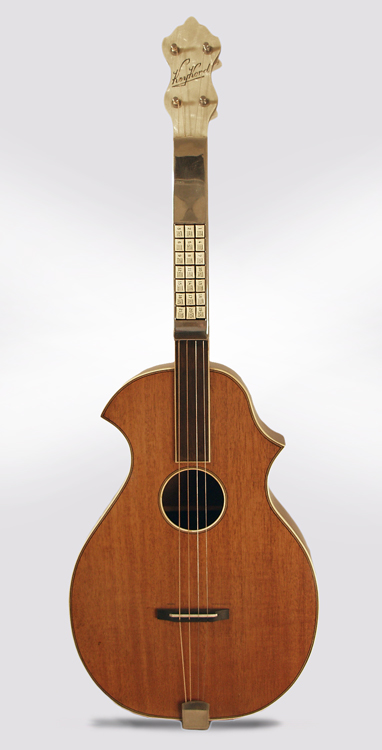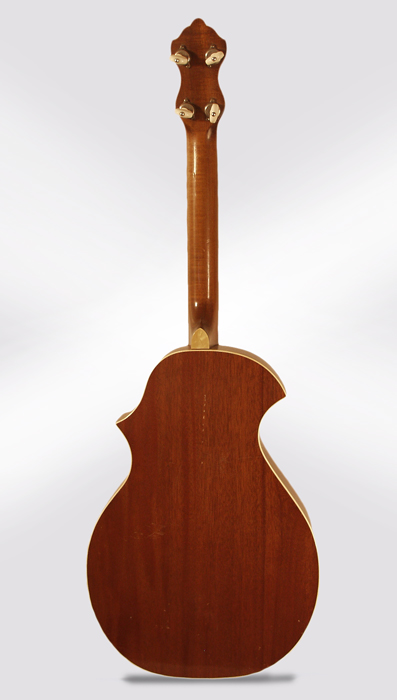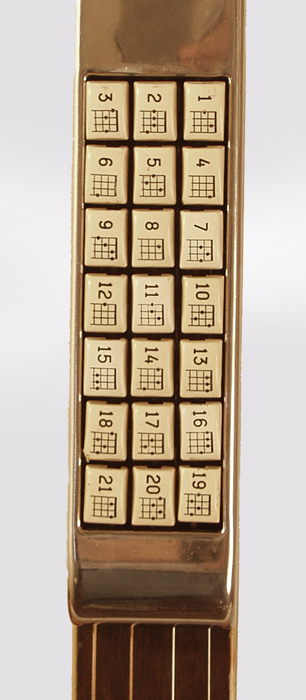KeyKord Tenor Guitar, made by Stromberg-Voisinet , c. 1928
This item has been sold.
Item # 5645
Prices subject to change without notice.
KeyKord Model Tenor Guitar, made by Stromberg-Voisinet, c. 1928, made in Chicago, natural lacquer finish, mahogany body and neck, ebonized fingerboard, original black hard shell case.
"Somebody paid a lot of money back in the late 1920's in order to avoid learning how to play the thing" is the classic KeyKord quote about this instrument from Tom Wheeler's AMERICAN GUITARS, and it still about sums up the story! The KeyKord series out of Chicago were a specialty contract for Stromberg-Voisinet, who later became Kay. They came with unfretted necks fitted with elaborate chord-fingering machinery mounted in a metal box above the fingerboard. The idea was instead of actually fingering chords, the player pressed a little illustrated tab with the chord symbol on it, strummed and voila!-the instrument played the chord for you!
This instrument was called a tenor guitar but is tuned to baritone uke tuning, and the chord symbols match those from the popular ukulele sheet music of the day although in practice it is playing in a different key! While this general idea would be revived more than once (as by Maccaferri in the 1950's) the keyKord was the most elaborate and ambitious exercise of the idea. Despite the ingenuity involved, these remain more of an amusing novelty than fully functional instrument...after all the "Guitar Hero" style video games are really the modern equivalent! This tenor guitar was a fairly elaborate creation with a full 21 chord tabs, a pearloid headstock with "KeyKord" incised and tabbed Grover tuners. An interesting piece of 1920's musical ingenuity and playable Americana.
Overall length is 31 1/2 in. (80 cm.), 11 1/8 in. (28.3 cm.) wide at lower bout, and 3 1/8 in. (7.9 cm.) in depth, measured at side of rim. Scale length is 20 in. (508 mm.). Width of nut is 1 7/16 in. (36 mm.). Some average light wear overall, there are a few small crack repairs to the top and back but nothing serious. The chord mechanism works about as well as these ever did-it "plays" with the occasional squeak or buzz, but you can make the correct chord sounds with the appropriate keys. A neat playable novelty from the 1920's, an era of endless invention! Includes the very rare original case. Excellent - Condition.
"Somebody paid a lot of money back in the late 1920's in order to avoid learning how to play the thing" is the classic KeyKord quote about this instrument from Tom Wheeler's AMERICAN GUITARS, and it still about sums up the story! The KeyKord series out of Chicago were a specialty contract for Stromberg-Voisinet, who later became Kay. They came with unfretted necks fitted with elaborate chord-fingering machinery mounted in a metal box above the fingerboard. The idea was instead of actually fingering chords, the player pressed a little illustrated tab with the chord symbol on it, strummed and voila!-the instrument played the chord for you!
This instrument was called a tenor guitar but is tuned to baritone uke tuning, and the chord symbols match those from the popular ukulele sheet music of the day although in practice it is playing in a different key! While this general idea would be revived more than once (as by Maccaferri in the 1950's) the keyKord was the most elaborate and ambitious exercise of the idea. Despite the ingenuity involved, these remain more of an amusing novelty than fully functional instrument...after all the "Guitar Hero" style video games are really the modern equivalent! This tenor guitar was a fairly elaborate creation with a full 21 chord tabs, a pearloid headstock with "KeyKord" incised and tabbed Grover tuners. An interesting piece of 1920's musical ingenuity and playable Americana.
Overall length is 31 1/2 in. (80 cm.), 11 1/8 in. (28.3 cm.) wide at lower bout, and 3 1/8 in. (7.9 cm.) in depth, measured at side of rim. Scale length is 20 in. (508 mm.). Width of nut is 1 7/16 in. (36 mm.). Some average light wear overall, there are a few small crack repairs to the top and back but nothing serious. The chord mechanism works about as well as these ever did-it "plays" with the occasional squeak or buzz, but you can make the correct chord sounds with the appropriate keys. A neat playable novelty from the 1920's, an era of endless invention! Includes the very rare original case. Excellent - Condition.



